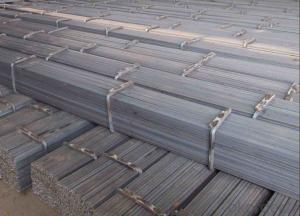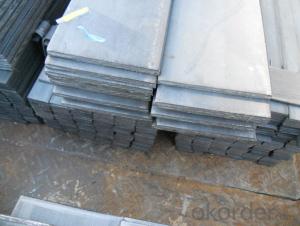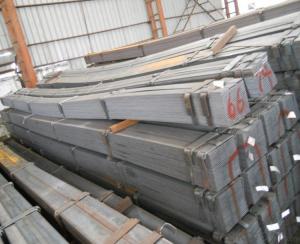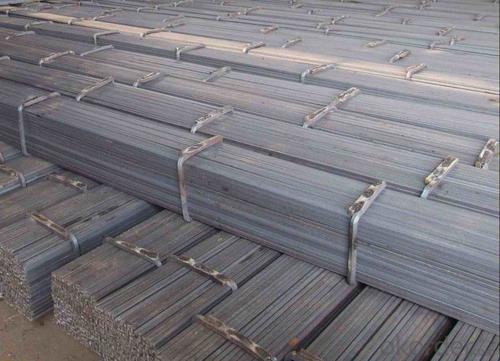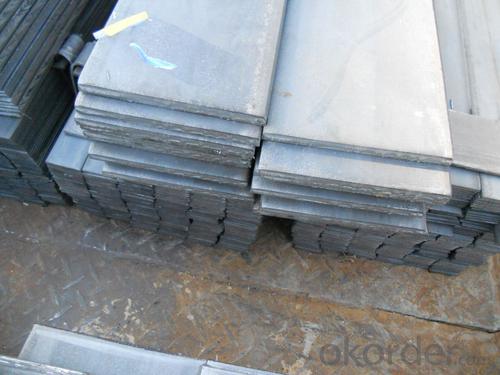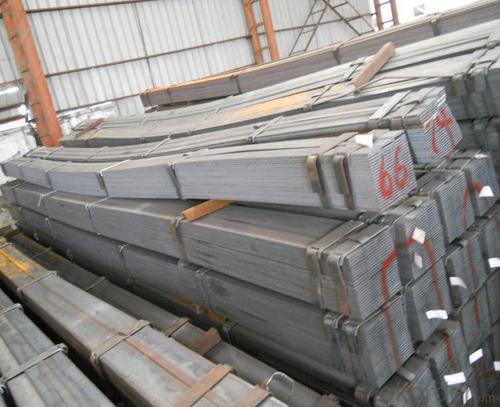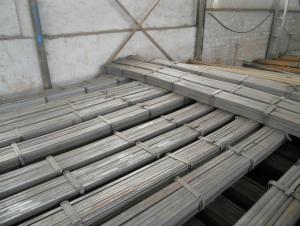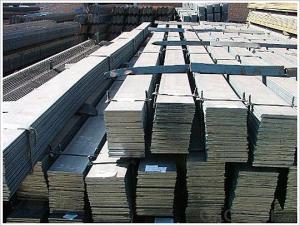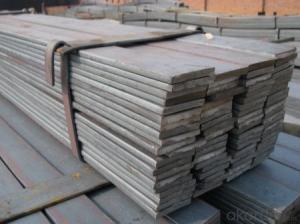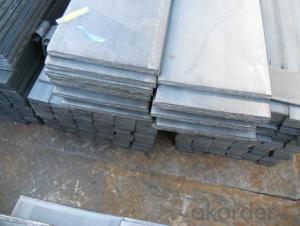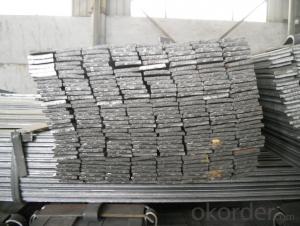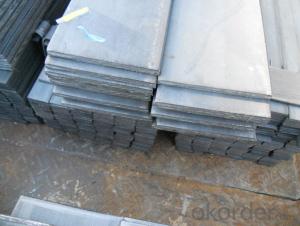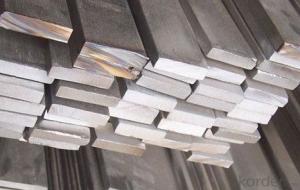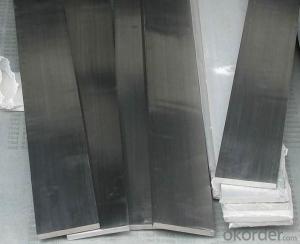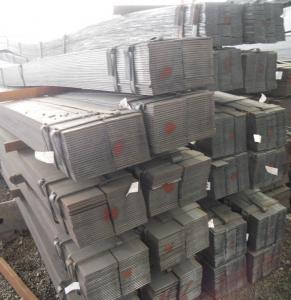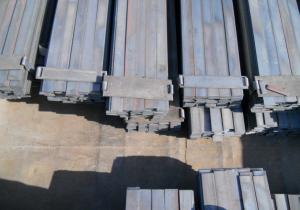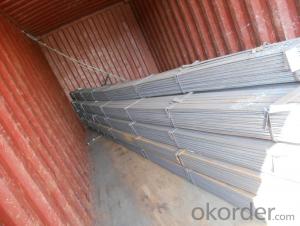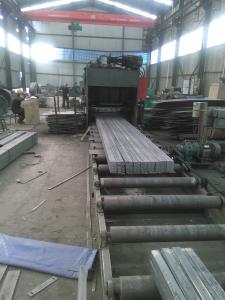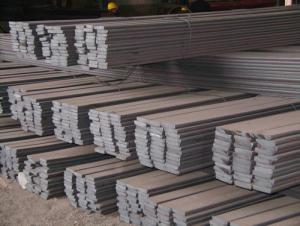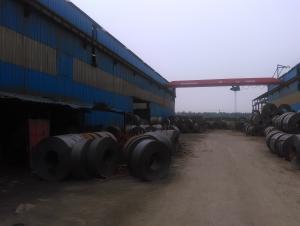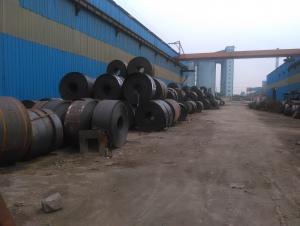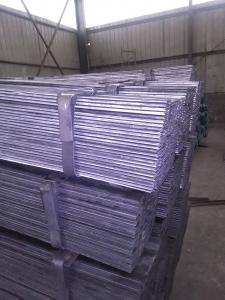High Quality Carbon Steel Flat Bar in Grade Q235
- Loading Port:
- Tianjin
- Payment Terms:
- TT OR LC
- Min Order Qty:
- 25 m.t.
- Supply Capability:
- 100000 m.t./month
OKorder Service Pledge
OKorder Financial Service
You Might Also Like
Specification of Carbon Steel Flat Bar
Commodity: Carbon Steel Flat Bar
Standard: GB,JIS,ASTM,
Material: Q235,SS400 or Equivalent
Brand name: FLATSPACE
Origin place: China
Thickness: 3mm-30mm
Width:20mm-200mm
Length: Max 12m
Certification: SGS/BV
Chemical composition of Q235
Alloy No | Grade | Element(%) | ||||
C
| Mn
| S
| P
| Si
| ||
Q235
|
B
|
0.12—0.20 |
0.3—0.7 |
≤0.045 |
≤0.045
|
≤0.3
|
Physical properties of Q235
Alloy No | Grade | Yielding strength point(Mpa) | Tensile strength (Mpa) | Elongation after fracture(%) | ||||||
Thickness (mm) | Thickness (mm) | |||||||||
≤16 | >16--40 | >40--60 | >60--100 | ≤16 | >16--40 | >40--60 | >60--100 | |||
≥ | ≥ | |||||||||
Q235 |
B |
235 |
225 |
215 |
205 |
375--500 |
26 |
25 |
24 |
23 |
Above sheets show the technical data of Q235,we can also provide other materials similar to Q235.
Usage/Applications of Carbon Steel Flat Bar
Widely used for construction;
Machinery manufacturing;
Iron tower steel structure;
Shipbuilding; Steel grating;
Staircase;
Bridge;
Viaduct;
Railway spare parts;
Boilers making etc.
Packaging & Delivery of Carbon Steel Flat Bar
Packaging Details: The Steel Flat Bars are packed in bundles and loaded in 20 feet/40 feet container, or shipped by bulk cargo ,also we can do as customer's requirements.
Delivery Details:30~45 days upon the receipt of buyer payment by T.T. or L/C.
- Q: How do you prevent warping or distortion of steel flat bars during heat treatment?
- To prevent warping or distortion of steel flat bars during heat treatment, several measures can be taken. Firstly, it is crucial to ensure that the bars are properly supported and evenly heated throughout the process. This can be achieved by using fixtures or jigs that hold the bars securely in place. Additionally, employing an appropriate heating technique, such as slow and uniform heating, can help minimize the risk of warping. It is also important to control the cooling process after heat treatment. Gradual and controlled cooling methods, such as furnace cooling or air cooling in a controlled environment, can help prevent rapid temperature changes that could lead to distortion. Lastly, proper handling and storage of the bars after heat treatment, including avoiding excessive stress or pressure, can further minimize the potential for warping or distortion.
- Q: What is the maximum weight steel flat bars can support?
- The maximum weight steel flat bars can support depends on various factors such as their dimensions, type of steel, and the structural support they are attached to. It is best to consult engineering specifications and load-bearing calculations to determine the maximum weight capacity accurately.
- Q: What are the different types of surface defects that can be found in steel flat bars?
- There are several different types of surface defects that can be found in steel flat bars. These defects can vary in severity and may affect the overall quality and performance of the steel. Some common types of surface defects include: 1. Scale: Scale refers to the thin layer of oxide that forms on the surface of steel during the hot rolling process. While it can be removed through various methods, it may still leave behind a rough or uneven surface. 2. Pitting: Pitting is characterized by small, localized depressions or craters on the surface of the steel. It can be caused by corrosion, improper storage, or manufacturing processes. 3. Scratches: Scratches are visible marks or lines on the surface of the steel, which can be caused during handling, transportation, or processing. While they may not affect the structural integrity, they can impact the aesthetic appeal of the steel. 4. Lamination: Lamination refers to the separation or splitting of steel layers along the surface. It can be caused by poor quality control during manufacturing or excessive rolling. 5. Roll marks: Roll marks are repetitive patterns or lines on the surface of the steel caused by the rolling process. These marks can affect the appearance and flatness of the steel. 6. Inclusions: Inclusions are non-metallic substances that are trapped within the steel during the manufacturing process. These include oxides, slag, or other impurities that can form visible spots or irregularities on the surface. 7. Decarburization: Decarburization occurs when the surface of the steel loses its carbon content due to exposure to high temperatures or improper heat treatment. This can result in a softer or weaker surface layer. 8. Cracks: Cracks are visible fractures or breaks in the steel surface, which can be caused by excessive stress, improper cooling, or poor manufacturing practices. These defects can significantly compromise the strength and integrity of the steel. It is important to inspect and identify these surface defects in steel flat bars to ensure that the material meets the required specifications and standards. Depending on the severity of the defect, appropriate measures such as grinding, polishing, or even rejecting the material may be necessary.
- Q: How do you cut steel flat bars?
- There are several methods to cut steel flat bars, depending on the desired precision and the tools available. Here are three common techniques: 1. Using a hacksaw: This is the most basic method and works well for small projects. Start by marking the desired cutting line on the steel bar using a measuring tape and a marker. Then, secure the bar in a vice to hold it steady. Grab a hacksaw with a bi-metal blade and begin cutting by applying steady pressure and using long, even strokes. It might take some time and effort, but with patience, you can achieve a clean cut. 2. Utilizing an angle grinder: An angle grinder equipped with a metal cutting disc is a more efficient option for cutting steel flat bars. Before starting, put on safety goggles and work gloves to protect yourself. Secure the bar in a vice and mark the cutting line. Then, position the angle grinder perpendicular to the bar and turn it on. Slowly guide the grinder along the marked line, applying moderate pressure. The cutting disc will create sparks, so it's essential to work in a well-ventilated area and avoid flammable materials. 3. Employing a metal-cutting band saw: If you have access to a metal-cutting band saw, this is the most precise and efficient method. Begin by adjusting the blade tension and aligning the saw's fence with the cutting line on the steel bar. Turn on the saw and slowly feed the bar into the blade, maintaining a steady pace. The band saw's teeth will cut through the steel smoothly, resulting in a clean and accurate cut. Remember to wear safety goggles and gloves when using power tools. Regardless of the cutting method used, after the steel flat bar has been cut, it might have sharp edges. To remove any burrs or roughness, use a file or a metal deburring tool to smooth the edges for a finished look.
- Q: Can steel flat bars be used for making playground equipment?
- Yes, steel flat bars can be used for making playground equipment. Steel is a durable and strong material that can withstand heavy use and weather conditions, making it suitable for constructing various playground structures such as monkey bars, slides, and climbing frames.
- Q: How do steel flat bars perform in high-pressure applications?
- Steel flat bars perform well in high-pressure applications due to their strength and durability. They can withstand the pressure exerted on them without deforming or breaking, making them suitable for use in various industries such as construction, manufacturing, and oil and gas. Additionally, steel flat bars have excellent corrosion resistance, ensuring their performance even in harsh environments.
- Q: What is the difference between hot-rolled and extruded steel flat bars?
- Hot-rolled and extruded steel flat bars are both commonly used in various industries, but they differ in terms of their manufacturing processes and resulting properties. Hot-rolled steel flat bars are produced by heating a billet or slab of steel above its recrystallization temperature and then rolling it through a series of rollers to achieve the desired shape and dimensions. This process leads to the formation of a scaled surface, as the steel is exposed to high temperatures. Hot-rolled steel flat bars are known for their strength and toughness, making them suitable for applications that require load-bearing capabilities, such as construction and infrastructure projects. They also tend to have a rougher surface texture compared to extruded steel flat bars. On the other hand, extruded steel flat bars are created by forcing a heated billet of steel through a die to produce the desired shape. The extrusion process results in a smooth and uniform surface finish, as the steel is not subject to the same high temperatures as in hot rolling. Extruded steel flat bars are known for their precise dimensions and consistent cross-sectional shape, making them ideal for applications that require tight tolerances, such as manufacturing machinery and architectural components. They also tend to have a finer surface finish compared to hot-rolled steel flat bars. In summary, the main difference between hot-rolled and extruded steel flat bars lies in their manufacturing processes and resulting properties. Hot-rolled bars are known for their strength and toughness, with a rougher surface texture, while extruded bars offer precise dimensions and a smoother surface finish, suitable for applications that require tight tolerances.
- Q: Are steel flat bars available in different surface hardness options?
- Yes, steel flat bars are available in different surface hardness options. The hardness of a steel flat bar's surface is determined by the type of heat treatment it undergoes during the manufacturing process. Heat treatment processes like quenching and tempering can be used to achieve different hardness levels in the surface of the steel. These hardness levels are typically measured on the Rockwell hardness scale, with higher numbers indicating greater hardness. Steel flat bars with different surface hardness options are commonly used in various industries, such as construction, manufacturing, and engineering, where specific hardness requirements are necessary for the intended application.
- Q: Are steel flat bars suitable for making brackets or supports for water treatment systems?
- Yes, steel flat bars are suitable for making brackets or supports for water treatment systems. Steel is known for its strength and durability, making it an ideal choice for supporting heavy equipment and withstanding the harsh conditions of water treatment systems. Additionally, steel flat bars can be easily fabricated and customized to meet specific requirements, ensuring a secure and stable support structure for the water treatment system.
- Q: Can steel flat bars be used in the manufacturing of material handling systems?
- Yes, steel flat bars can be used in the manufacturing of material handling systems. Steel flat bars are versatile and durable, making them suitable for various applications in the manufacturing industry. They can be used to construct frames, supports, and components in material handling systems such as conveyor belts, storage racks, and pallet handling equipment. Steel flat bars provide strength and stability, ensuring the safe and efficient movement of materials within a facility. Additionally, their flat shape allows for easy attachment of other components, such as rollers or brackets, further enhancing their usefulness in material handling systems.
Send your message to us
High Quality Carbon Steel Flat Bar in Grade Q235
- Loading Port:
- Tianjin
- Payment Terms:
- TT OR LC
- Min Order Qty:
- 25 m.t.
- Supply Capability:
- 100000 m.t./month
OKorder Service Pledge
OKorder Financial Service
Similar products
Hot products
Hot Searches
Related keywords
